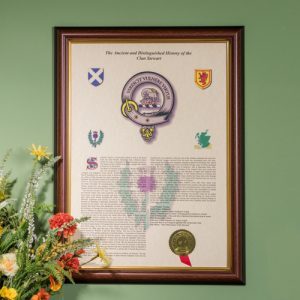Your basket is currently empty!

The mysteries behind coats of arms and family crests
Posted on
Embark on an enlightening journey into the captivating world of heraldry, as we unravel the mysteries behind coats of arms and family crests.
These emblematic representations have been around since the 1100s. They serve as unique identifiers on the battlefield, and as symbols of family lineage and honour. In this article, we delve into the elements that make up a coat of arms, their significance, and how you can discover if your surname is connected to a medieval coat of arms.
What was a coat of arms used for?
Coats of arms and family crests are akin to a special logo that was used in times of old to represent one’s family during battles. This distinctive emblem encapsulates the individual’s origin, values, and achievements, making it a powerful and personal symbol. The coat of arms is not merely a decorative piece; it is a comprehensive visual narrative, with each element bearing its own significance.

Unravelling the mysteries of coats of arms.
The most prominent feature of a coat of arms is the shield. This central piece serves as the canvas for the rest of the elements. The symbols depicted on the shield, known as Charges, could range from animals, plants, and weapons, to abstract shapes and patterns. These symbols had a functional purpose too, as they were featured on the shield, clothing, and even over the knight’s horse and on the banner, making for a brightly coloured battlefield.
What about the crest?
Sitting atop the shield is the crest, typically an animal, bird, or other creature, often representing the family’s values or accomplishments. As the medieval period progressed, the importance of armour, especially for head protection, increased. The helmet itself also bore symbols, ensuring that the knight and his steed were entirely covered in meaningful symbolism.
On either side of the shield, you might find figures or animals known as Supporters. These are usually animals significant to the family or the region. Another key element is the motto, a short phrase or saying that appears on a ribbon or scroll on the shield. The motto often expresses the family’s values, beliefs, or aspirations and is often in Latin.
The mysteries of coats and arms and family crests can be solved if you know how to interpret the symbols. Our dictionary might be able to help – click here.

A coat of arms was a personal possession and a matter of pride. No one but the knight himself had the right to bear the coat of arms, but he could pass it on to his descendants. Having the same name as someone does not automatically give you the right to use the coat of arms. If two noble families joined by marriage, their heraldry was combined by ‘quartering’. This is where the varying symbols featured on different parts of the shield.
Was there ever a coat of arms for your name?
Are you curious to know if your own name is connected to a medieval coat of arms? It’s free to check! Just type in your name at the top of this page today and start your journey of discovery into your surname. You can find out if there was ever heraldry connected to your surname and learn all about its early origins. With a coat of arms and surname history scroll, you can view the earliest heraldry for your name. Plus, it comes complete with a bibliography of sources on the reverse. With over a million surnames available, you might just uncover a fascinating piece of your family’s history.
Are coats of arms still used?
Today, we have moved on from the medieval period, and coat of arms are no longer used in the same way. However, many families retain their coat of arms as a symbol of their heritage and history. Some even choose to create their own version, incorporating modern elements that reflect their values and accomplishments. If you are interested in creating a coat of arms for your family, many designers specialise in creating unique and personalised designs. These must be sanctioned by the College of Arms in order to be used in any official capacity.
Do you have to be aristocratic?
Despite their historical significance, it’s essential to note that coat of arms are not exclusive to noble or aristocratic families. Anyone can create and use their own coat of arms as a symbol of their family’s identity and values. In today’s global society, a coat of arms can serve as an excellent way to celebrate your heritage and to connect with your family’s past.
In conclusion, delving into the world of heraldry is a fascinating journey that can reveal much about your family’s history and identity. Whether you are exploring your surname’s origins or creating your own coat of arms, the symbols and elements of heraldry provide a rich tapestry of meaning and significance that has endured for centuries. So why not start your own journey of discovery today and uncover the secrets of your family’s coat of arms?


Leave a Reply